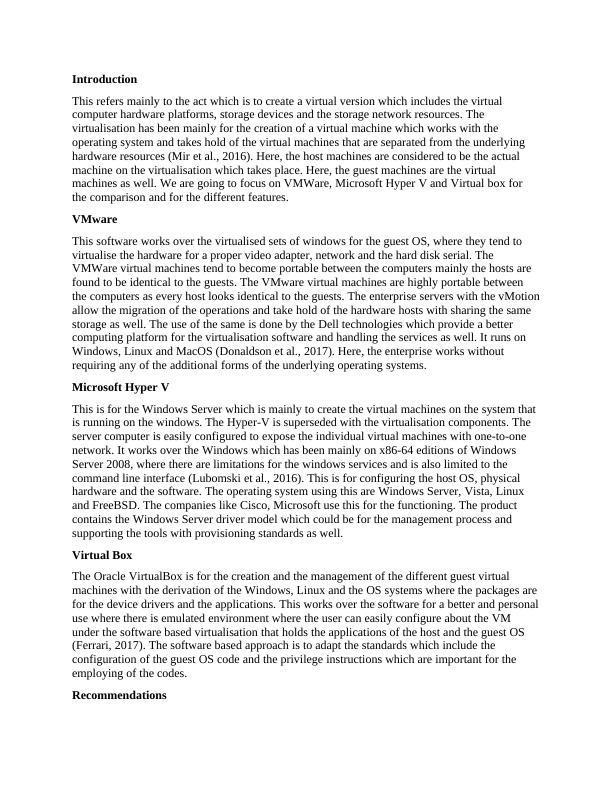Implementation of Virtualization in Software
Added on 2020-05-01
2 Pages926 Words92 Views
IntroductionThis refers mainly to the act which is to create a virtual version which includes the virtual computer hardware platforms, storage devices and the storage network resources. The virtualisation has been mainly for the creation of a virtual machine which works with the operating system and takes hold of the virtual machines that are separated from the underlying hardware resources (Mir et al., 2016). Here, the host machines are considered to be the actual machine on the virtualisation which takes place. Here, the guest machines are the virtual machines as well. We are going to focus on VMWare, Microsoft Hyper V and Virtual box for the comparison and for the different features. VMwareThis software works over the virtualised sets of windows for the guest OS, where they tend to virtualise the hardware for a proper video adapter, network and the hard disk serial. The VMWare virtual machines tend to become portable between the computers mainly the hosts are found to be identical to the guests. The VMware virtual machines are highly portable between the computers as every host looks identical to the guests. The enterprise servers with the vMotionallow the migration of the operations and take hold of the hardware hosts with sharing the same storage as well. The use of the same is done by the Dell technologies which provide a better computing platform for the virtualisation software and handling the services as well. It runs on Windows, Linux and MacOS (Donaldson et al., 2017). Here, the enterprise works without requiring any of the additional forms of the underlying operating systems.Microsoft Hyper V This is for the Windows Server which is mainly to create the virtual machines on the system that is running on the windows. The Hyper-V is superseded with the virtualisation components. The server computer is easily configured to expose the individual virtual machines with one-to-one network. It works over the Windows which has been mainly on x86-64 editions of Windows Server 2008, where there are limitations for the windows services and is also limited to the command line interface (Lubomski et al., 2016). This is for configuring the host OS, physical hardware and the software. The operating system using this are Windows Server, Vista, Linux and FreeBSD. The companies like Cisco, Microsoft use this for the functioning. The product contains the Windows Server driver model which could be for the management process and supporting the tools with provisioning standards as well.Virtual BoxThe Oracle VirtualBox is for the creation and the management of the different guest virtual machines with the derivation of the Windows, Linux and the OS systems where the packages arefor the device drivers and the applications. This works over the software for a better and personaluse where there is emulated environment where the user can easily configure about the VM under the software based virtualisation that holds the applications of the host and the guest OS (Ferrari, 2017). The software based approach is to adapt the standards which include the configuration of the guest OS code and the privilege instructions which are important for the employing of the codes. Recommendations

End of preview
Want to access all the pages? Upload your documents or become a member.
Related Documents
Virtual Machine Configurationlg...
|7
|991
|236
Window Server 2012 using VMware Workstationlg...
|137
|14476
|90
VMWare for Proposal and Procurement Reportlg...
|2
|951
|39
Implementation of Server Virtualizationlg...
|23
|5038
|305
Installation and Configuration of IIS on Windows Server 2012lg...
|17
|1165
|138
Information System Threats Attacks and Defenceslg...
|35
|2571
|18
